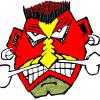The Schroeter et al. article gives some details on the estimated amount of PAs ingested by the Kunas:
–)-Epicatechin mediates beneficial effects of flavanol-rich cocoa on vascular function in humans
Flavanol Consumption in Kuna Indians. As an initial test of whether or not the chronic consumption of a high-flavanol diet is associated with a persistent augmentation of NO-production, we studied two genetically closely related populations of Kuna Indians. Indigenous Kuna Indians, who live in the San Blas islands off the coast of Panama, represent a very propitious study population because they have only minimal increases in blood pressure with age, and hypertension and other CVDs are rare. The factors involved are primarily environmental, rather than genetic, because this protection is lost upon migration to mainland Panama City (25). One contributing factor seems to be dietary because the Kuna living on San Blas customarily consume large amounts of flavanol-rich cocoa (26). In the current study, urine samples collected from a subset of individuals, who were partaking in a larger study aimed at investigating diet-blood pressure correlations in the Kuna (27), were analyzed for flavanol metabolites and nitrite+nitrate concentrations. All volunteers partaking in this study where matched for age, gender, and weight. Island-dwelling Kuna consumed an average of 3–4 cups of cocoa per day. Those living on the mainland consumed on average <4 cups per week. The cocoa powder used on the island contained 0.196 g of total procyanidins per g (33). Reasonably assuming that the cocoa beverage contained an average of 10 g of cocoa powder per 100 ml of fluid, and defining the average volume of a cup to be 100 ml, the typical daily procyanidin intake on the island was in the range of 600–900 mg. Consistent with the above estimates, urinary levels of flavanol metabolites, expressed as epicatechin equivalents, are more than six times higher in island dwellers than in mainland inhabitants (Fig. 4, which is published as supporting information on the PNAS web site). Although the dietary records predicted a higher urinary nitrate+nitrite level in mainland inhabitants as compared with island dwellers, the sum of urinary nitrite+nitrate levels in island dwellers (n = 16) is more than twice that of Kuna living on the mainland (n = 18) (Fig. 4).
Now, the above 0.196 g value should be actually 0.0196 g, or 20 mg, to yield a total of 600-900 mg (10 grams of cacao powder each 100 ml cup, 3-4 cups per day).
Going back to the USDA Database for the Proanthocyanidin Content of Selected Foods, Release 2 – 2015, assuming that the procyanidins are the same as proanthocyanidins (they are condensed tannins), polymers from 2 to n molecules of catechins, we have 4251 mg per 100 g of unprocessed cacao powder on the average.
According to the above, 900 mg of procyanidins-proanthocyanidins are found in about 20 grams of undutched, average cacao powder.
Now, i'm not sure whether procyanidins=proanthocyanidins, and am not sure that the Scrhoeter et al estimates are very rigorous.
But even allowing for 50% the amounts, we are in the region of 40 grams of cacao powder, as previously stated.
Edited by mccoy, 20 March 2017 - 11:15 PM.




















































